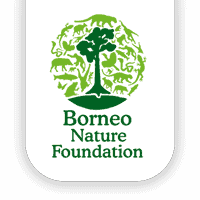Borneo Nature Foundation (BNF) Indonesia together with the Sebangau National Park Agency (BTNS), conducted a training session on identification, inventories, and monitoring of biodiversity, for the Sebangau National Park Forest Ecosystem Controller (PEH) functional staff. This two-day training event was held at the BTNS Office and Sungai Koran Resort Sebangau Hulu on March 10-11, 2021.
“BTNS together with partners want to make the Sebangau National Park (TNS) level up to be better, and more advanced, with the expertise of PEH’s functional personnel also becoming more advanced. All of that can happen if the technical capacity of friends at BTNS increases,” said Head of BTNS Andi Kadhafi when giving a speech at the BTNS Office.
The participants of the training event included 15 functional personnel of Sebangau National Park. Acting as facilitators are BNF field staff in Sebangau, BNF Camera Trap Coordinator Adul, BNF Biodiversity Monitoring Coordinator Iwan, and Forestry and Orangutan Survey Coordinator Santiano.

Photo by Yohanes Prahara | BNF
Andi added that this exercise was intended to provide a refresher and increase the capacity of the Sebangau National Park PEH functional staff, presented by experienced field practitioners and BNF field coordinators. The aim of this training was to understand the importance of biodiversity monitoring for conservation and to study existing methods for monitoring biodiversity (species richness, distribution, abundance, population monitoring, biological indicators).
“This training is also to understand how biodiversity monitoring data can be processed and used to support conservation actions,” he added.
Andi hopes that through the need for data and research, future monitoring and observations can be facilitated in different stages, for example calculating carbon emissions and carbon stocks, as well as writing scientific articles, an area in which BNF is very experienced. He thanked BNF Indonesia for assisting the management of the Sebangau National Park area by facilitating capacity building for human resources (HR).
In the same place, Deputy Director II of BNF Indonesia, Agnes Ferisa, explained that this training had more of a technical nature, the participants learnt the theory in the office and then immediately went to practice in the field. This is so that the methods taught are easier to understand when practised directly, such as learning how to prepare camera trap surveys, including location, camera settings, species identification, data processing, and data analyses.
“Together, we learned to conduct a nest survey to assess the density of the orangutan population, the different survey techniques, how to identify species, collect morphological data, identify environmental variables, process data, and analyse basics. We are also studying how to prepare surveys and collect key data for bioindicators,” Agnes added.
Agnes concluded that this training activity was a follow-up event to the collaboration on biodiversity functions in Sebangau National Park. She also hopes that this cooperation can continue to maintain the integrity of the Sebangau habitat and the biodiversity within it.



